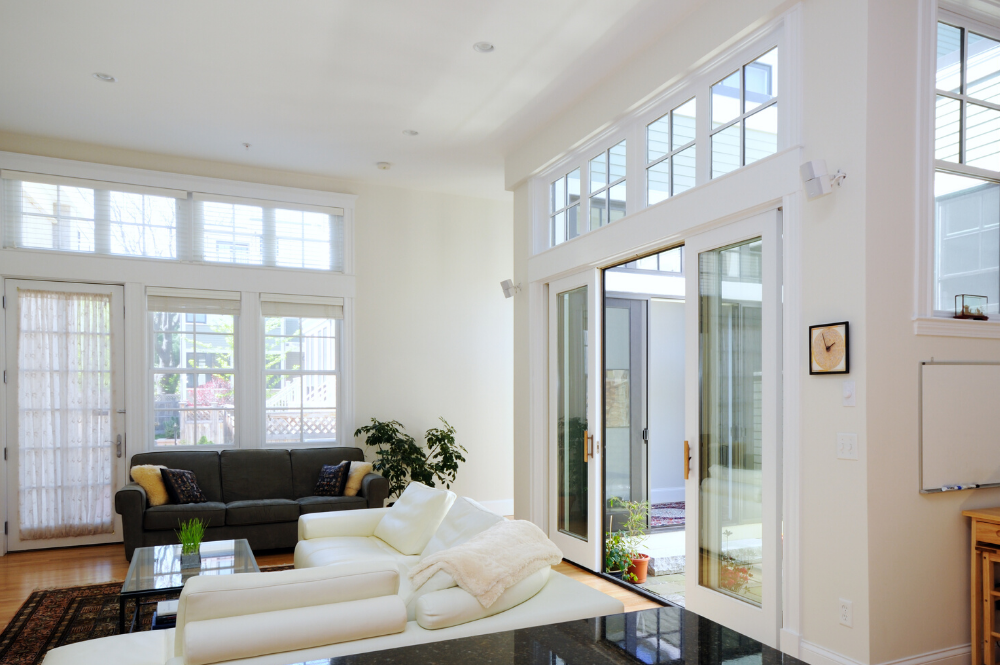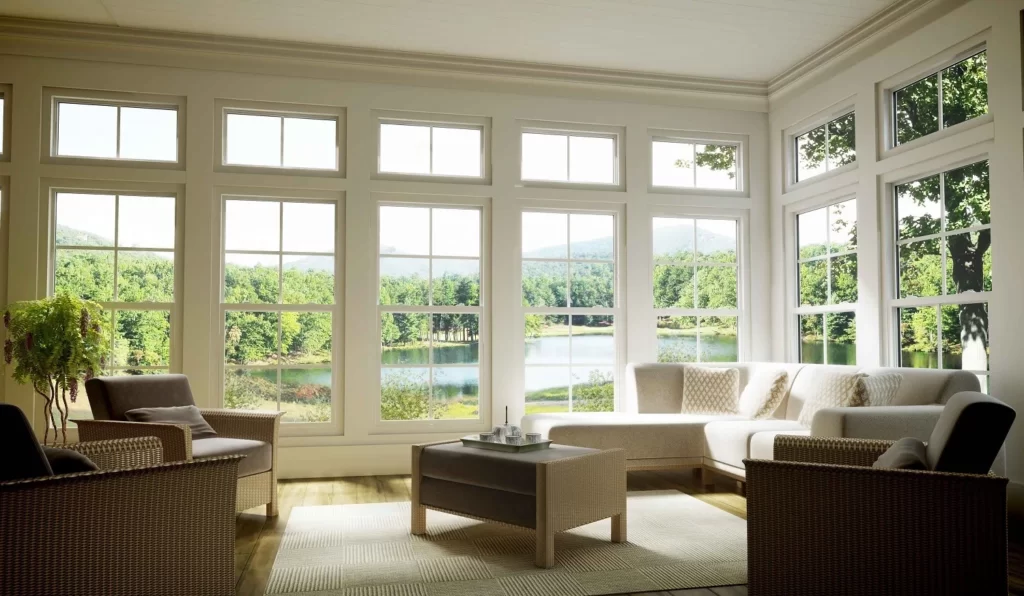Today, in a world where sustainable energy and green living are highly coveted, selecting the appropriate windows and doors for your house or business is essential. If you’re considering upgrading your windows and doors or choosing the most efficient option in a construction project, it is essential to be aware of the varieties of windows and doors and choose the most energy-efficient ones.
What Makes Energy Saving Windows And Doors Efficient?
Windows that are energy-efficient are designed to minimise the heat and cold transfer between a building’s interior and exterior. They are outfitted with cutting-edge methods and supplies intended to improve a building’s insulation, lessen air leakage, and boost thermal efficiency. Let’s explore what are the most energy-efficient windows available on the market today.
Window Options:
Two of the most well-known techniques to improve energy efficiency are triple-pane and double-pane windows. They are constructed of two or three layers of glass wedged together with the help of gas. This gas acts as an additional insulator, reducing heat transfer and energy loss through the window. Triple-pane windows provide better insulation than double-pane windows due to the additional glass layer and gas fill.
Low-E Coatings:
Low-emissivity (Low-E) coatings consist of very thin, almost invisible layers applied to the glass surfaces. They are designed to reflect heat away from the room while allowing sunlight to enter. Low-E coatings effectively reduce heat transfer, keeping the room cooler in summer and warmer in winter. Windows with Low-E coatings have high energy efficiency and can significantly reduce cooling and heating costs.
Insulated Frames:
While glass plays a significant role in window efficiency, the frame also plays an important part. Frames made of insulation materials such as Thermally broken Aluminium, fibreglass, vinyl, or wood are designed to decrease energy conductivity and prevent heat transfer or loss through the frame. They improve insulation and lessen the possibility of humidity accumulating within the glass. They increase insulation and reduce the chance of condensation inside the glass.
Gas Fills:
Certain energy saving windows and doors use gas fills between the glass panes to enhance insulation. Krypton and Argon gases are typically used for this purpose. These gases are denser than air and provide greater thermal insulation, up to 1000 times better than air, reducing heat transfer through the windows. Gas-filled windows can be particularly efficient in harsh climates where insulation is crucial for maintaining indoor comfort.
Window Styles:
The design of the window you choose can also affect its energy efficiency. Casement windows, made of casement frames, provide a secure seal when closed, reducing the possibility of air escape. They are highly efficient when combined with triple-pane or double-pane glass and Low-E coatings. Awning windows are another energy-efficient option as they allow for great airflow while preventing rainwater from entering the space. Fixed windows, although lacking airflow capabilities, provide an airtight seal. In Australia, casements have a downside as screening opens into the room allowing mosquitoes to enter. In Australia, we have Sliding windows that give greater openings for fresh air to enter the home or awning windows that can be screened.
Energy Star Ratings:
When searching for energy-efficient windows, look for those with the Energy Star label. Energy Star windows undergo rigorous testing and are confirmed to meet or exceed performance standards, ensuring their effectiveness in reducing energy consumption and greenhouse gas emissions.
Solar Heat Gain Coefficient (Shgc) And Window U-Factor:
The U-Factor measures the speed of heat transfer through the window, with lower values indicating better insulation. The SHGC measures the amount of solar radiation absorbed through the windows, with lower values indicating less energy loss. Selecting windows with low U-Factor and SHGC values can significantly improve energy efficiency and ensure a pleasant indoor climate.
Framing Materials:
The material used for window frames also affects energy efficiency. While wood frames have natural insulation qualities, they may require lots of maintenance. On the other hand, vinyl frames are low maintenance and offer good thermal efficiency and can be considered in a lower-cost property. Aluminium frames, although lightweight and durable, are not the most thermally efficient and can contribute to minor heat loss or gain, UW-value, Thermally broken aluminium windows are considered the best architecturally and will add value and last the best in the Australian market.
Proper Installation:
Regardless of the efficiency of the window frames, their effectiveness can be compromised if not properly installed. Proper installation involves ensuring a secure connection between the window frame and the wall, using appropriate insulation materials, and addressing potential air gaps or leaks. It is recommended to hire a skilled window installation expert with experience in energy-efficient windows to maximise the effectiveness of your windows.
Considerations For Replacement Windows:
If you are considering replacing your existing windows with energy saving windows and doors, it is important to evaluate the overall condition of your windows and frames. In some instances, weatherstripping or retrofitting the current windows may be more economical and cost-effective than replacing the entire frame. You can choose the best course of action by speaking with a window installation expert.
Impact Of Window Orientation:
The orientation of windows in relation to the sun’s rays can impact their energy efficiency. Proper use of shading methods such as awnings, exterior blinds, or window films can help mitigate extreme temperatures. North-facing windows receive less direct sunlight and may require windows with higher SHGC values to maximise solar gain in warmer climates.
Energy-Efficient Glass Options:
In addition to Low-E coatings, advancements in glass technology have led to the development of specialised energy-efficient glass options. Triple-glazed windows, for example, have an additional layer of glass that provides increased insulation and noise reduction. Some manufacturers offer spectrally-selective coatings that allow sunlight to pass through while blocking a significant portion of the sun’s radiation. These innovative glass options improve energy efficiency and can be tailored to specific climate conditions.
Other Energy-Saving Features:
To further enhance the effectiveness of your windows and doors, consider additional options such as window tinting or window films. These can help reduce glare, block harmful UV rays, and improve thermal efficiency. Additionally, using curtains, blinds, or shades can add an extra layer of insulation by reducing heat loss or gain.
Different climates have distinct heating and cooling needs, and windows that are energy efficient in one location may not be as effective in another. Consulting with a professional window installer or supplier can help you determine the best windows to meet your specific needs. Most blogs available are European-based and do not transfer effectively to Australia’s climatic conditions.
In conclusion, the most efficient windows incorporate various features, including triple-pane or double-pane glass, Low-E coatings, gas fills, insulated frames, and the appropriate window style. These windows are specifically designed to limit heat transfer, minimise air loss, and enhance thermal efficiency, resulting in reduced energy consumption and improved indoor living conditions. It is important to choose windows that are Energy Star certified to ensure their energy efficiency and environmental sustainability.



